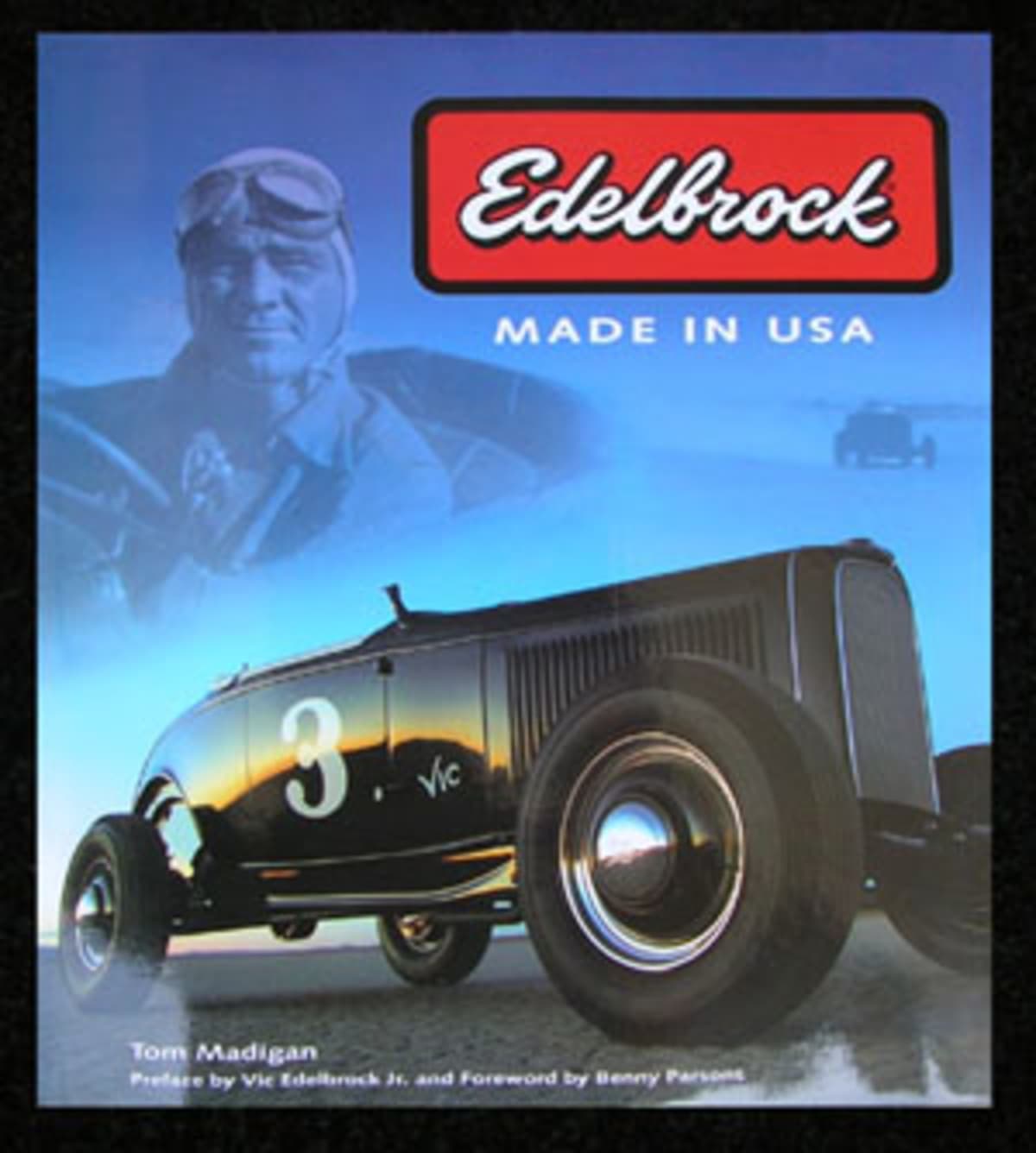AMERICAN TALE TOLD WELL: BOOK REVIEW - EDELBROCK, MADE IN USA
This article is from our archives and has not been updated and integrated with our "new" site yet... Even so, it's still awesome - so keep reading!
Published on Mon, Jul 4, 2005
By: The LACar Editorial Staff
AMERICAN
TALE TOLD WELL
EDELBROCK, MADE IN USA
by Tom Madigan
St Paul, MN: Motorbooks
International, 2005
Hard Bound; 324 pages; 200+ photos
1.2d x 10.5w x 11.7h
ISBN: 0-7603-2202-3
$40 (USA)
Review by HAROLD OSMER
If you recognize the name Edelbrock. If you have wondered why some guys make it in business while others
fail. If you want to know how an American company can get ahead and stay ahead. If you have been to a drag, oval, or lakes race. If you have ever added aftermarket parts to your car. If you have ever raced a car or boat. If you are curious about how the automotive speed merchants came to be. If you are looking for an inspirational formula to success. If you are any sort of car guy who grew up in the last half of the 20th century. Then you should get this book.
Author Tom Madigan has done a terrific job of presenting the long, storied history of the Edelbrock Corporation in a fast-paced, readable manner with 200 photos, inside information, anecdotes, and remarkably candid insight. As you might expect, the history of Edelbrock Corporation closely follows the Edelbrock family history.
Otis Victor Edelbrock Sr. came to California from Kansas during the Depression. He decided early on that the best way to make something of himself was to own a business as opposed to working for someone who could take advantage of his skills. He was a talented, efficient mechanic and had little trouble in finding employment, but always ached for the day when he could open his own shop. His first rented space was a four stall repair shop at a Gilmore Service Station near Hoover and Venice at Cortland Street.
Depression-era people, even in Southern California, were typically short on cash and often operated their cars well beyond their expiration dates. Model T Fords, Cadillacs, Hudsons, Studebakers, as well as the occasional Franklin, Peerless, and Durant came through his shop. Vic's willingness to work on anything coupled with an innate ability to fix almost anything soon brought him a loyal customer base and his business grew. He eventually found a larger shop in an upscale neighborhood and moved in 1934. The new place had more affluent customers more in need of maintenance than keep-her-running repairs. Vic was constantly evolving as both mechanic and business owner.
In and around this same time frame, hot rodders were finding their way to the dry lake beds and oval tracks sprouting up around Southern California. Vic's attention to mechanical detail often gave him an edge over the typical backyard guys and he soon had racers coming to his shop in search of more speed. Through initiative, knowledge, and the occasional stroke of luck, Vic managed to incorporate changes into the existing products available. When those no longer satisfied him, he began designing and making his own.
That's how it all got started and Tom Madigan does a great job of laying it all out in this book. The author deftly ties social times in context with the racing scene both in Southern California and across America. Madigan sets the scene well by explaining the important role played by Southern California in racing history through technology, venue development, and sheer number of opportunities on all sides of the wheel. That the Edelbrock Corporation started here is no mere coincidence. Unfortunately, the author does, at one point, credit Phil Hill for Parnelli Jones' exploits. But that's all just background for the larger story at hand.
Vic became Vic Sr when Vic Jr came on the scene in 1936. Vic kept very long hours and relied heavily on his wife, Katie, to keep the household afloat and she would often bring home-cooked meals to the shop. Vic Jr started sweeping floors and polishing race cars at an early age and learned how to bench race by watching and listening intently after working hours.
A couple of points permeating the story are that Vic Sr was willing to work as hard as he had to in order to be successful on his own. He was selective in his friends but also loyal and supportive, expecting the same in return. Vic had mechanical know-how and also kept looking for ways to solve problems and make things work better. In an era when most people were generally more mechanically able, he looked beyond the immediate problems and worked toward a future. It's unlikely he ever considered a developing a classic business model, but that's what he followed nonetheless. His name appeared prominently on all his parts which became synonymous with high quality and performance. By 1959 the Edelbrock Corporation was one of the largest manufacturers of speed equipment in the country.
Vic Jr was thrust into the company leadership position with the untimely death of his father in 1962. A graduate of USC business school, Vic Jr had the benefit of growing up with an inside line on the automotive aftermarket industry. The combination of street and
book smarts would serve him well throughout his career as he was able to communicate directly with his individual customers as easily as he could politicians, bureaucrats, and corporate executives. As the racing game evolved and matured, so, too, did the Edelbrock Corporation. The company responded with equal vigor when confronted with the 1970s concerns for fuel economy and efficiency.
Madigan brings the story to the current time and details some of Vic Jr's involvement with boat racing. Edelbrock's Fun Team is ever-present at major vintage race meets and racing with his daughters has proven to be a great way to earn bragging rights at the next family dinner. I do feel that the author gives too much detail when writing about Vic Jr's family. While important to the overall Edelbrock philosophy, the point of family importance had already been made and is overdone here.
"Edelbrock, Made in USA" has 324 pages covering all this history, answering many questions and explaining the hows and whys of the automotive aftermarket. What spurs new designs? How did SEMA form? Why does Edelbrock insist on producing in America? How did they do all they have done and how do they keep doing it?
After reading "Edelbrock, Made in USA" you will come to understand that Vic Sr was first and foremost a dedicated family man. Everything he created was ultimately tied to the notion that he was responsible for making his family comfortable. He used this same approach in his work and products, striving at all times to make his customers both successful on the track and happy on the street.
Vic Jr combined his father's ethics and experience with his own enthusiasm and education to keep the company high on the wave of change brought about by the 1960s, '70s, and beyond. Both men relied upon strong, capable wives who fulfilled multiple significant roles in the Edelbrock story. Overall, this is an American tale told well.








